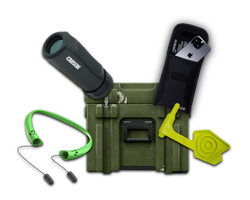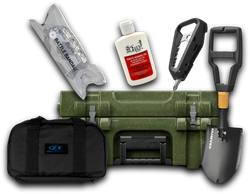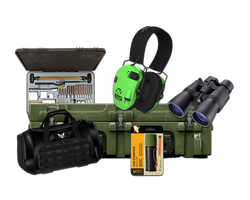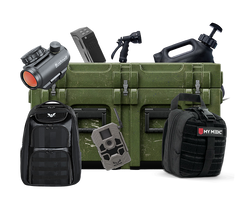How to Set Up a Sleeping Bag for Maximum Comfort and Efficiency
Table of Contents
- Introduction
- Selecting the Right Sleeping Bag
- Preparation Before Setup
- Setting Up Your Sleeping Bag
- Care and Maintenance of Your Sleeping Bag
- Conclusion
Introduction
Imagine you're nestled by a crackling campfire, the stars twinkling overhead, and the scents of the wilderness enveloping you. The perfect ending to a day of adventure is a restful night spent in the great outdoors. However, if your sleeping bag is improperly set up, that dream can quickly turn into a nightmare of discomfort and poor sleep. Learning how to set up a sleeping bag correctly is crucial for anyone who wishes to maximize their comfort and ensure a great night’s rest in the wild.
This blog post will delve into the essential aspects of setting up a sleeping bag, providing you with practical tips and techniques. From choosing the right sleeping bag for your trip to properly setting it up and maintaining it, we will cover it all. By the end of this article, you will not only understand how to set up a sleeping bag effectively but also appreciate the importance of quality gear in enhancing your outdoor experience.
Why It Matters
Choosing the right sleeping bag and setting it up correctly can significantly impact your sleep quality. Proper insulation, comfort, and protection from the elements are vital for a good night's sleep outdoors. With the right knowledge and preparation, you can avoid common pitfalls that lead to discomfort, such as inadequate insulation or moisture retention.
In this post, we will cover several key topics, including:
- Selecting the Right Sleeping Bag: Types and temperature ratings.
- Preparation Before Setup: Choosing a campsite and preparing your sleeping area.
- Setting Up Your Sleeping Bag: Proper techniques for achieving maximum comfort.
- Care and Maintenance: How to extend the life of your sleeping bag.
Let’s dive in and explore the world of sleeping bags, ensuring you are fully prepared for your next outdoor adventure.
Selecting the Right Sleeping Bag
The first step in ensuring a comfortable night under the stars is selecting the right sleeping bag. There are various styles, materials, and temperature ratings to consider.
Types of Sleeping Bags
-
Mummy Bags: These are designed to hug your body closely, providing maximum warmth and minimal weight. They are ideal for cold environments but may feel restrictive to some users.
-
Rectangular Bags: Offering more space and comfort, these bags allow for movement but are generally heavier and less efficient in retaining heat.
-
Semi-Rectangular Bags: A hybrid of the two, providing a balance between warmth and comfort.
Temperature Ratings
Understanding the temperature ratings of sleeping bags is crucial. Most sleeping bags are rated for three seasons (spring, summer, and fall) and have temperature ratings indicating the lowest temperature at which they can keep you warm.
- Summer Bags: Rated above 35°F (1.7°C) for warm-weather camping.
- Three-Season Bags: Rated between 10°F (-12°C) to 35°F (1.7°C) for versatility.
- Winter Bags: Rated below 10°F (-12°C) for extreme cold conditions.
Material Considerations
- Down Insulation: Lightweight, compressible, and very warm. However, down loses insulation when wet.
- Synthetic Insulation: Retains warmth when wet and is generally more affordable. It is bulkier than down.
Crate Club Recommendations
At Crate Club, we offer a variety of high-quality tactical gear, including sleeping bags suitable for every adventure. Our curated collections are designed to ensure you have the best tools for your outdoor experiences. Explore our Crate Club Shop for outstanding options.
Preparation Before Setup
Before even unrolling your sleeping bag, a few preparatory steps can greatly enhance your sleeping experience.
Choosing the Right Campsite
Selecting an ideal spot for your campsite is crucial. Look for:
- Level Ground: Avoid sloped areas where you might roll off during the night.
- Protection from Wind: Seek natural barriers like trees or bushes.
- Distance from Water Sources: Avoid sleeping too close to rivers or lakes to prevent dampness.
Preparing Your Sleeping Area
-
Clear the Ground: Remove rocks, sticks, and debris to create a smooth surface.
-
Utilize a Sleeping Pad: An insulated sleeping pad adds an extra layer of warmth and cushioning. It helps insulate you from the cold ground and provides comfort.
-
Consider a Ground Sheet: This can protect your sleeping bag from moisture and dirt.
Setting Up Your Sleeping Bag
Now that you've selected the right bag and prepared your campsite, it's time to set up your sleeping bag properly.
Unpacking and Positioning
-
Unroll the Bag: Lay your sleeping bag out flat and give it a few moments to loft if it's down-filled. This allows the insulation to expand, maximizing warmth.
-
Orient the Bag: Ensure the opening of the bag is positioned correctly, allowing for easy entry.
-
Check Zipper Functionality: Make sure the zipper works smoothly to avoid any frustration when getting in or out of the bag.
Entering the Sleeping Bag
-
Change Clothes: Before getting into your sleeping bag, change into dry, comfortable layers. Avoid wearing damp clothing as it can lower your body temperature.
-
Slide In: Sit at the foot of the bag and slide your feet in first, followed by your legs. This minimizes drafts.
-
Adjust the Hood: If your sleeping bag has a hood, adjust it to encase your head, reducing heat loss.
Techniques for Maximizing Comfort
-
Layering: If you expect colder temperatures, consider using a sleeping bag liner or an additional blanket for added warmth.
-
Ventilation: In warmer weather, unzip the bag partially for ventilation, allowing a comfortable airflow.
-
Movement: If you feel restricted, consider choosing a bag with a wider cut or a design that allows for more movement.
Final Touches
Ensure that the sleeping bag is positioned away from the edges of your sleeping pad to avoid any cold drafts from the ground.
Care and Maintenance of Your Sleeping Bag
Proper care and maintenance can significantly extend the life of your sleeping bag, ensuring it stays warm and functional for years to come.
Storage Tips
-
Avoid Long-Term Compression: When not in use, store your sleeping bag loosely in a breathable storage sack or hang it in a closet. This preserves the insulation loft.
-
Use a Stuff Sack for Transport: During trips, use a compression sack for easy transport, but avoid storing it in this manner for extended periods.
Cleaning Your Sleeping Bag
-
Read the Care Label: Always check the manufacturer's instructions for cleaning.
-
Spot Clean When Possible: For minor stains, spot cleaning may suffice.
-
Washing: If a full wash is necessary, use a front-loading washing machine with a gentle detergent. Air dry the bag thoroughly, ideally in a large dryer with dryer balls to restore the loft.
Conclusion
Setting up a sleeping bag properly is a key element in ensuring that your outdoor experience is enjoyable and restful. By selecting the right bag, preparing your campsite, and using proper techniques for setup and maintenance, you can maximize your comfort and effectiveness in the wild.
Remember, quality gear makes a significant difference. Crate Club is dedicated to providing you with the best tactical and survival gear to enhance your outdoor adventures. Explore our Crate Club Subscription Services to discover curated gear that keeps you prepared for any situation.
FAQs
Q: How do I know what temperature rating to choose for my sleeping bag?
A: Consider the climate and conditions of your camping location. If you expect cooler temperatures, opt for a bag with a lower temperature rating.
Q: Can I use my sleeping bag for different seasons?
A: Yes, but it is best to have different bags for summer and winter conditions. Three-season bags are a versatile solution for spring, summer, and fall camping.
Q: How do I prevent moisture from getting into my sleeping bag?
A: Use a ground sheet and ensure your sleeping area is dry. Store your sleeping bag in a waterproof stuff sack when it rains.
Q: Is it okay to store my sleeping bag compressed?
A: No, long-term compression can damage the insulation. Store it loosely in a breathable storage sack.
By applying the insights from this guide, you can ensure your next camping trip is comfortable and enjoyable. Prepare well, and the great outdoors will reward you with unforgettable experiences.
Share this article



